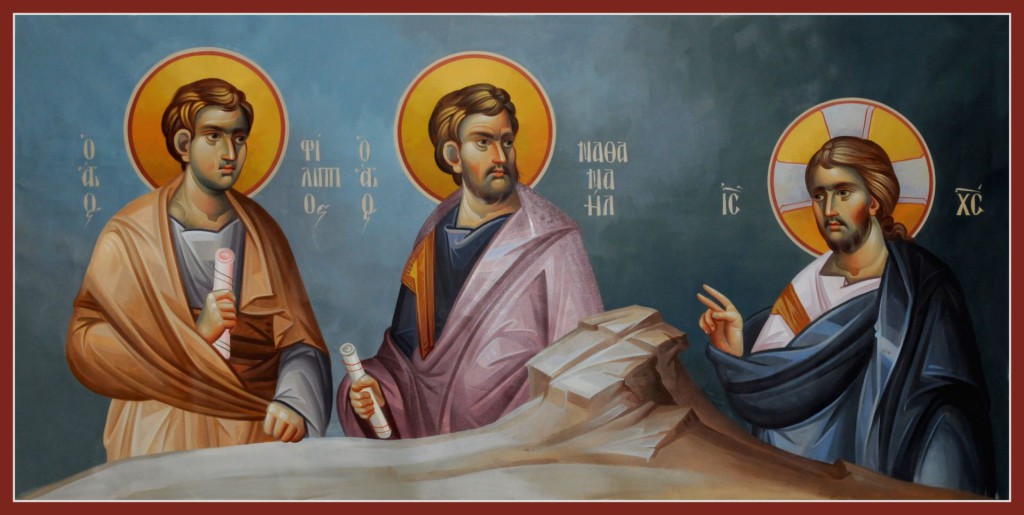
Sunday of Orthodoxy, March 1, 2015
Rev. Fr. Andrew Stephen Damick
In the Name of the Father and of the Son and of the Holy Spirit, one God. Amen.
“Philip said to him, ‘Come and see.'”
This phrase, which we hear in today’s Gospel, has come to be something of an evangelistic watchword among English-speaking Orthodox Christians. “Come and see.” It is used especially with the sense that there is something here in the Orthodox Church that is worth looking at.
And of course when you enter into an Orthodox church, there is a lot to look at—icons, architecture, candles, vigil lamps, vestments, and so on. And there is much to hear and smell and touch and taste. Orthodoxy is a sensory experience that really is unrivaled among Christians. There are other kinds of churches that have some of these elements, and there are some that have other things to fill the senses, such as loud music and flashy light shows, but there really isn’t anything in Christianity like the aesthetic experience of Orthodox Christianity.
Nothing looks like an Orthodox church. Nothing sounds like an Orthodox church. Nothing smells like an Orthodox church. And especially here in the cultural West, most people have no idea what those experiences are like. They’ve mostly never even heard of us. Many fewer still have actually walked into one of our churches.
So it’s perfectly understandable that, when we are doing our evangelism, we may say to someone “Come and see,” and then follow that invitation with a description of what you’ll see here and experience here with all your senses.
And since this is the Sunday of Orthodoxy, where we celebrate the restoration of icons to our churches, we may be particularly likely today to say “Come and see,” while we are thinking about iconography in the back of our heads. I don’t think there’s anything wrong with talking about our church in those terms.
But I do think there’s something wrong if we leave it there. Why?
First, I want you to imagine that we are a brand-new mission parish. Maybe we’re worshiping in a store-front space. There are no icons on the walls. There is no iconostasis. We might have a couple of lecterns instead with icons on them. Imagine also that we have no trained musicians. We find a couple people with just sort of okay voices who maybe have no training in Orthodox music. All they can manage is a repetitive, maybe even atonal chanting that is tough to listen to for a long time. And so on. Imagine everything in a really basic, bare-bones fashion, maybe even somewhat painful to deal with in one way or another.
Here in Emmaus, we enjoy much more than all that, but that is a real situation that many parishes face in some of those ways or perhaps even all those ways. Is it likely that people will advertise that parish by saying, “Come and see”? Not, really. But is that still Orthodoxy? Yes.
Of course it would not be an ideal situation, and we would work to rectify it, but it would still be authentically part of the Orthodox Church. Nonetheless, this little thought experiment reveals the problem with our making the invitation to “Come and see” about aesthetic experience. It is not that those aesthetics are wrong or even unnecessary—they are both right and properly part of the Orthodox faith—but they place the emphasis on the wrong place.
To understand this, we need to look again at what is meant by the invitation to “Come and see” when it is first given in the Gospel. These words are uttered by Philip when he is speaking to Nathanael. Let’s listen to this passage again:
“Philip found Nathanael, and said to him, ‘We have found Him of Whom Moses in the Law and also the Prophets wrote, Jesus of Nazareth, the son of Joseph.’ Nathanael said to him, ‘Can anything good come out of Nazareth?’ Philip said to him, ‘Come and see.’”
So Philip is inviting Nathanael to come and have a look at Jesus, to see for himself whether “anything good [can] come out of Nazareth.” Then Nathanael goes with Philip to meet Jesus.
But the phrase also appears earlier in the chapter, prior to our reading appointed for today. In this section (John 1:38-39), which is shortly before today’s reading, Jesus is asked by some of the disciples of John the Baptist where He is living, and Jesus responds to them, “Come and see.” And it says that they went and saw and then stayed with Him for a day.
So what’s going on here? In neither case is this phrase “Come and see” connected to having an aesthetic experience. Both are a response to curiosity—in the earlier case, the curiosity of John’s disciples as to where Jesus was staying and in the latter case, it is in response to Nathanael’s sarcastic question as to whether anything good could come out of Nazareth, which was clearly “the wrong side of town.”
Both both ultimately have the same object. Both times “Come and see” is said, the purpose is the same. What is it that these people are being invited to “come and see”? It is not icons or architecture or chanting or incense or any kind of spectacle or aesthetic experience.
They are being invited to have an encounter with Jesus.
This is the heart of our Gospel, the heart of the good news that we preach to the nations and not just to the nations but to our nation, to our neighborhood, to our own family and our friends. We preach Jesus. We invite people to “come and see” Jesus.
If in our preaching we focus on all these things about Orthodoxy that are good and normative but we never mention their actual purpose, then we are not preaching the good news. The good news is not that we have beautiful churches and iconography and chanting and so on. That is not the good news.
The good news is that God became man, lived as one of us, died as one of us, and then rose from the dead to bring us all into resurrection with Him. That is the good news.
And that is what the iconography preaches, too. And the chanting. And the incense. And so on and on.
When we say “come and see,” it is because we want people to have the encounter with Jesus that we have had. We have come and seen Him. We have found “Him of Whom Moses in the Law and also the Prophets wrote, Jesus of Nazareth, the son of Joseph.” This is the One Whom we have come to see. And this is the One Whom we have invited the world to come and see.
This is good news. This is evangelism. This is the preaching of the Gospel to every creature on earth, shouting it not just from the rooftops but into the whole of the cosmos—that Jesus Christ has come to earth to rescue all of mankind and indeed the whole world from the bondage of sin and corruption and death.
Do you believe that? Do you really believe it? Then of course you will be telling people to “come and see.” If you really believe that—and I hope that you do—then when you tell people all about our beautiful icons and singing and so on, you will tell them why it is all so beautiful. It is because all these things together preach one message: Come and see Jesus Christ, the Son of God and the Saviour of the world.
To Him therefore be all glory, honor and worship, with His Father and the Holy Spirit, now and ever, and unto ages of ages. Amen.


Wonderful sermon, Father! Blessings!